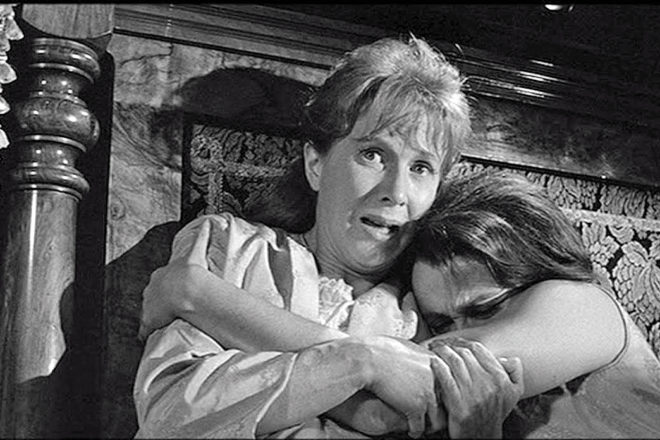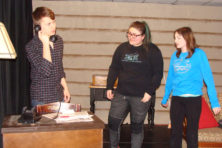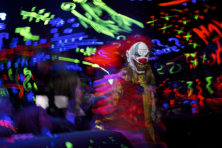‘The Haunting’ Still Haunts
- Share
- Tweet
- Pin
- Share

“The dead are not quiet in Hill House.”
Here is my recipe for a creepy good time. Get a copy of the 1963 movie The Haunting, turn off the lights and watch what I maintain is the best of the ghost stories.
Shot in gorgeous black and white, with a mysterious and sometimes jarringly atonal soundtrack by Arnold Schoenberg disciple Humphrey Searle, and from a story by Shirley Jackson, “Well, Well,” as main character Eleanor “Nell” Lance (Julie Harris) says upon arriving at Hill House.
The soundtrack turns brassy when she firsts sets sight on the mansion, which director Robert Wise shot with infrared film to make Hill House even more dramatic than it is, and it works. The house seems to pulse with life in those establishing infrared shots.
Robert Wise is one of the great directors. He began his career as a film editor. He was Orson Welles’ editor on both Citizen Kane and The Magnificent Ambersons. He later went on to work with producer Val Lewton, the master of low budget horror with monsters implied rather than shown on screen.
That experience as an editor seemed to give Wise an unusually strong visual sense and storytelling ability. Here are just a few worthy Robert Wise movies – Born to Kill, (1947) a tough film noir starring the soon-to-be infamous Lawrence Tierney; The Set-Up (1949), a tough boxing movie shot in real time and starring Robert Ryan as 35-year-old has-been Stoker Thompson; the amazing Cold War-era philosophical/film noir sci-fi thriller The Day the Earth Stood Still (1951); The Captive City (1952), a true story of a newspaper editor’s stand against organized crime and rampant corruption; The Desert Rats (1953); Odds Against Tomorrow (1959, shot with infrared film); Star Trek: The Motion Picture (1979).
The Haunting was made in between Wise winning two best director Oscars for two blockbuster musicals – 1961’s West Side Story and 1965’s The Sound of Music.
The Haunting is the ultimate haunted house story. A researcher chooses three people to spend time in Hill House to stimulate the strange forces in the house. One character is invited for her psychic perception (Claire Bloom portrays the lesbian psychic Theo).
Julie Harris’s character is there because of a poltergeist experience that happened to her as a child.
And Russ Tamblyn, portraying cynical skeptic Luke Sanderson is there because he is a nephew of the owner.
My favorite character is creepy housekeeper Mrs. Dudley (beautifully played by English actress Rosalie Crutchley). She sets the tone in an exchange with Eleanor upon her arrival at Hill House.
Mrs. Dudley: We live over in town, miles away.
Eleanor Lance: Yes.
Mrs. Dudley: So there won’t be anyone around if you need help.
Eleanor Lance: I understand.
Mrs. Dudley: We couldn’t hear you. In the night.
Eleanor Lance: Do you have any idea when Dr. Markway…
Mrs. Dudley: [cuts her off] No one could. No one lives any nearer than town. No one will come any nearer than that.
Eleanor Lance: I know.
Mrs. Dudley: In the night. In the dark.
[Mrs. Dudley grins and leaves]
That exchange is a thing of beauty. And the follow-up scene when Mrs. Dudley attempts to repeat the lines to the just-arrived Theo, but Eleanor interjects with uncharacteristic humor. All of this material is directly from Shirley Jackson’s book.
In those pre-computer graphic times, Robert Wise used his experience as a filmmaker to create the sense of dread that envelops The Haunting, from the infrared introduction of Hill House, to the use of music, camera placement and editing to heighten suspense, to agreeing to sign a memo acknowledging the imperfection of a 30mm anamorphic, wide-angle lens Panavision camera that was not technically ready for use because it caused distortions. The Panavision folks didn’t understand that Wise wanted the distortion for certain moments in The Haunting.
The 1999 remake has plenty of CGI and is not worth your time. But don’t take my word for it. Everyone involved was nominated for Razzie Awards, which are awarded to the worst movies of the year.




